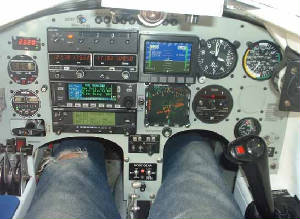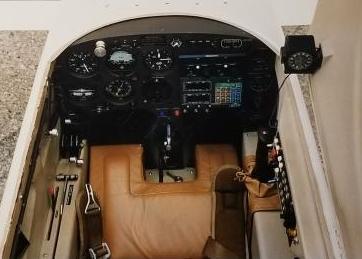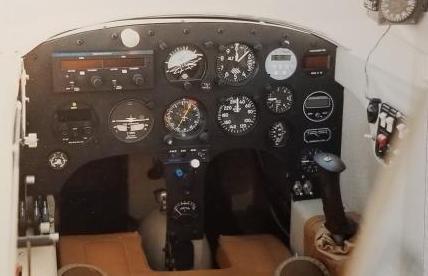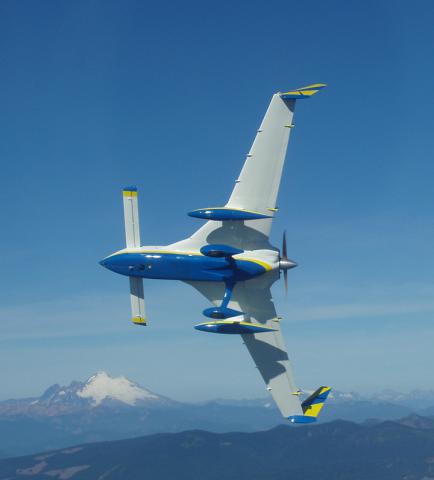



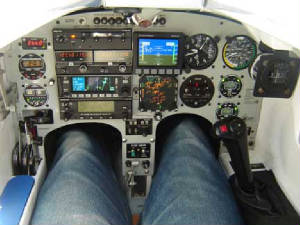
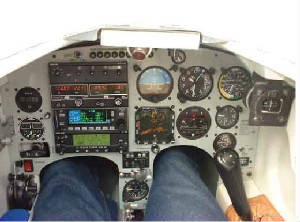
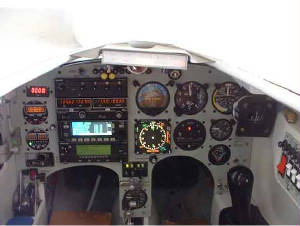
Avionics
Kay often jokes that when the airplane sees me walking towards it with a pair of wire cutters, it gets nervous, because it knows I am going to undertake another upgrade to its avionics. I must admit that there is an element of truth to the saying. As a Systems Engineer in my day job, I spend a lot of time trying to make an airplane be greater than the sum of its parts, and my own plane is no different.
Below is the progression of the cockpit, which also reflects some of the major trends in instruments. Although I have yet to go to large flat panel displays, I am sure it is only a matter of time.
This is the first major upgrade to my panel, undertaken in April 1990. I eliminated the LORAN, re-arranged the instruments so that I didn't have to reach across the panel to tune radios, and incorporated a glideslope input from the Narco NavComm to the HSI.
Here is how the instrument panel appeared when I first saw the plane in March 1990. Notice the LORAN occupying most of the right side of the panel. To make any changes to the navigation inputs, you had to reach completely across the panel to tweak the LORAN.
The HSI was a Narco DGO-10 connected to the VOR. It did not show glideslope and was not connected to a gyro. The ADI was electrically driven.
February 1997 - My first attempt to create true IFR capability. I installed a new suite of BendixKing avionics, including a KT-76A transponder, KLX-135A GPS/Com, and a KLX-125 NavComm which provided me with ILS capability, all slaved to the DGO-10 HSI. This installation was the first where I did my own wiring, instead of having it done by an avionics shop.
I also included a Marker Beacon and multi-channel engine monitor from Electronics International. One step back was the inclusion of a vacuum-powered artificial horizon.
2001 saw the end of an enormous undertaking - completing the transformation of the Long-EZ from a primarily VFR airplane to a true IFR machine. The installation of a KLN-94 IFR GPS and Sandel SN3308 HSI, both with color moving maps, gave me true situational awareness. Wiring the project turned out to be an enormous undertaking which I couldn't have done without the help of some of the techs at work.
April 2003, I stated that this instrument panel would hopefully be the last. It was a nice dream, while it lasted.
It represented a switch from an automotive digital tach to a JPI digital tach, freeing up room to move the clock from a side panel to the main panel. Additionally, I installed a JPI fuel flow totalizer in the left side panel.
So much for the "last" upgrade. As a friend of mine says, when my instrument panel sees me coming, it quakes in fear. In April 2005, I added a Dynon EFIS-D10A to replace my existing vacuum pump and gyro system. It saved over 5 pounds of total aircraft weight and gave me a system that is significantly more reliable.
September 2005 - This time I have an excuse. My back just couldn't handle the load of picking up the nose all the time, so I finally broke down and installed one of Jack Wilhelmson's electric nose gear extension system. At the same time, I removed the G-meter (the Dynon displays G's) and snaked the manual back-up system between the radio stack and the Sandel display.
March 2007 - I just can't leave well enough alone. Actually, I wanted to add a fuel level indicator, since my back and neck are now too stiff to see the rear seat site gages. While I was at it, I modified the glareshield and warning and caution light system, both to better annunciate issues, as well as to keep them from obstructing my view of the instrument panel.
May 2011 – I eliminated the last of my steam gages (airspeed and altimeter) since they were redundant to the Dynon D10A EFIS. In their place, I located a Garmin Aera 510, featuring Datalink weather and traffic, received from a Zaon PCAS XRX hidden in the nose. Although not a fully integrated suite, it gives me the same capabilities, but for a whole lot less money.
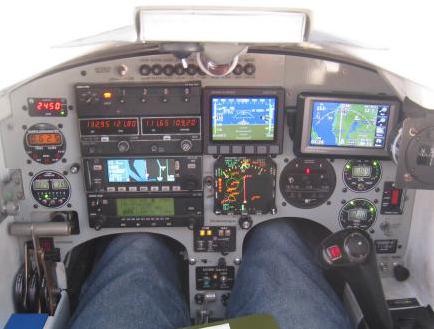
May 2018 –What started as an effort to comply with the ADS-B mandate led to a complete re-work of all my avionics. I followed a rigorous process to decide what to get, leading to the selection of an all-Garmin package: GTN 650 GPS/VOR/ILS/COM, G5 Standby Attitude indicator, G3X Touch display with autopilot, GTR 20 remote VHF comm, GNC 307 autopilot control head, GMA245R remote audio control panel, and GTX45R remote Mode S transponder. With this equipment, I meet all U.S. and European mandates.

